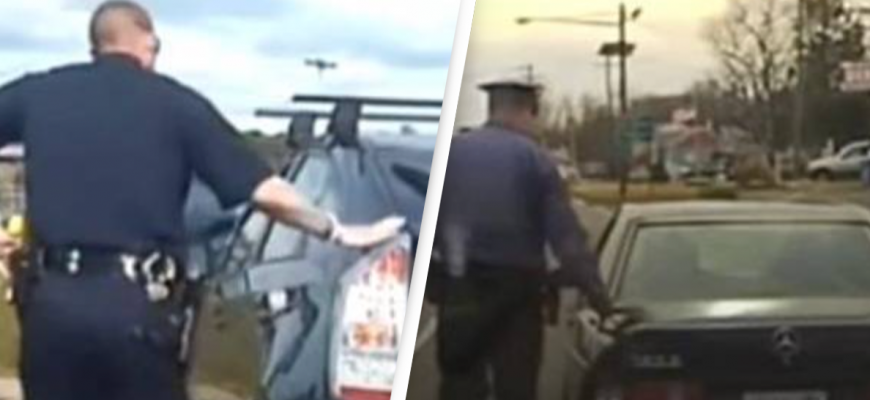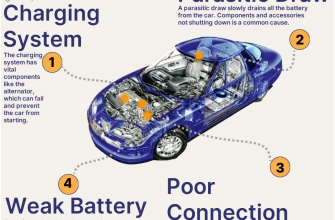Traffic stops can be a source of anxiety and confusion for many drivers. Among the various actions that police officers take during these encounters, one peculiar action stands out: the officer’s tendency to touch your car. This seemingly innocuous gesture raises questions for many drivers who wonder about its purpose and implications. In this article, we will explore the reasons behind this practice, shedding light on its significance in the context of law enforcement and driver safety.
1. Establishing Presence and Control
One of the primary reasons officers touch your car during a traffic stop is to establish their presence and exert control over the situation. By placing a hand on your vehicle, officers create a physical connection that signals authority. This action serves to remind the driver that the officer is in charge, thereby setting the tone for the interaction.
This method of establishing control is not just about authority; it also serves a practical purpose. In high-stress situations, officers need to assess the environment quickly. Touching the car allows them to gauge the driver’s demeanor and the overall atmosphere around the vehicle. It can help them identify potential threats and make informed decisions to ensure their safety.
2. Evidence Collection
Another reason for this behavior pertains to evidence collection. By placing their hand on your car, officers may be subtly marking the vehicle. This can serve as a means of documenting the interaction. Should there be any subsequent disputes regarding the stop, the officer can refer back to their notes, which may include details like the time of the stop and the condition of the vehicle at that moment.
Furthermore, if an officer suspects that the driver may be involved in illegal activity, touching the car can leave behind potential fingerprint evidence should the situation escalate. This action can also indicate to other officers responding to the scene that a stop has occurred and that they should approach with caution.
3. Safety and Officer Awareness
Safety is a paramount concern for law enforcement officers during traffic stops. By touching the vehicle, officers can create a barrier of awareness between themselves and the driver. This act signals to the officer that their own safety is being prioritized, allowing them to remain alert to any sudden movements or actions taken by the driver or passengers.
Moreover, in the event of an unexpected situation, such as a driver attempting to flee or conceal a weapon, the officer can use their physical contact with the car as a point of leverage. This awareness helps officers maintain their position and react quickly if necessary.
4. Communication and Connection
Touching the car can also serve as a form of non-verbal communication. It creates a moment of connection between the officer and the driver. This gesture can help to humanize the situation, making it clear that the officer is not merely a figure of authority but also a person who is engaging with the driver. This connection can sometimes lead to a more cooperative interaction, as drivers may feel less intimidated when they sense a level of approachability from the officer.
5. The Role of Training and Protocols
Police officers undergo extensive training that includes protocols for conducting traffic stops. These training sessions emphasize the importance of safety, communication, and control. As part of this training, officers are taught the significance of touching the vehicle during stops. It is a practiced behavior aimed at ensuring that the encounter proceeds smoothly while prioritizing both the officer’s and the driver’s safety.
While the action of touching your car during a traffic stop may seem trivial or confusing, it serves multiple important purposes. From establishing authority and ensuring safety to aiding in evidence collection and fostering communication, this gesture is a nuanced part of the law enforcement process. Understanding these reasons can help demystify the experience of a traffic stop, empowering drivers with knowledge and clarity in potentially tense situations.
Next time you find yourself pulled over, remember that the officer’s touch is more than just a habit; it’s a calculated move designed for safety and control in a complex environment.
6. Legal Implications
Understanding the reasons behind police touching your vehicle during a traffic stop also invites a discussion about the legal implications of such actions. Courts have generally upheld this practice as a reasonable measure for officers to ensure their safety and the safety of others during a stop. However, it is essential to recognize that the officer’s approach must remain within the bounds of legality and respect for individual rights. Knowing your rights during a traffic stop can empower you to advocate for yourself while still maintaining a level of respect and cooperation with law enforcement.
7. Psychological Aspects
Beyond the practical reasons, there are psychological aspects at play as well. The act of touching the car can evoke a range of emotions in drivers. For some, it may induce feelings of intimidation or fear, while for others, it might offer a sense of reassurance that the officer is professional and in control. Understanding these emotional responses can help both drivers and officers navigate the complexities of these interactions more effectively, fostering a more constructive dialogue.
8. The Evolution of Traffic Stops
Traffic stops have evolved over the years, influenced by changes in societal attitudes, law enforcement training, and technology. With the rise of body cameras and dashboard video recordings, the actions of officers during traffic stops are under greater scrutiny than ever. This increased transparency has led to a more significant focus on the protocols and behaviors of officers, including the act of touching the vehicle. As these practices are more closely examined, officers are becoming more aware of how their actions can be perceived and the importance of maintaining a balance between authority and community trust.
9. Best Practices for Drivers
For drivers, understanding the rationale behind police actions during traffic stops can lead to better outcomes. Here are some best practices to keep in mind:
- Stay Calm: Regardless of the situation, try to remain calm. Your demeanor can influence the officer’s approach and the overall tone of the interaction.
- Follow Instructions: If an officer requests certain actions—such as providing your license and registration—comply respectfully.
- Communicate Clearly: If you need to reach for something, communicate that intention clearly to the officer to avoid misunderstandings.
- Know Your Rights: Familiarize yourself with your rights during a traffic stop. Understanding your rights can help you navigate the encounter more effectively.
- Document the Encounter: If you feel uncomfortable or if something seems inappropriate during the stop, make a note of the officer’s name, badge number, and any relevant details. This documentation can be useful if you need to file a complaint later.
10. Conclusion
As we navigate the complexities of modern law enforcement, fostering mutual respect and understanding can lead to better outcomes for everyone involved. Remember, knowledge is power, and understanding the “why” behind police actions can make a significant difference in how you experience a traffic stop.










This article really sheds light on a topic that many drivers often overlook. Understanding the reasons behind police actions during traffic stops is crucial for fostering better interactions. Great read!
This article is fantastic! I had no idea that touching the car could serve as evidence collection too. It’s great to see such important information shared with the public.
A well-written article that addresses a common concern among drivers. Knowing why officers touch vehicles can definitely help ease some of the anxiety associated with traffic stops.
I found this article to be very informative and helpful in understanding police procedures during traffic stops. Knowledge is power, and this piece definitely empowers drivers!
Such an enlightening read! This article highlights aspects of traffic stops that most people don’t consider. It’s crucial for both drivers and officers to understand these interactions better.
I never thought about the significance of officers touching my car during a stop. This article explains it so well, and now I feel more informed and prepared for future encounters. Thank you!
I appreciate how this article breaks down the reasons behind police behavior during traffic stops. It
A very insightful piece! The explanation about establishing control and presence is spot on. It’s important for drivers to understand these dynamics to reduce anxiety during stops.